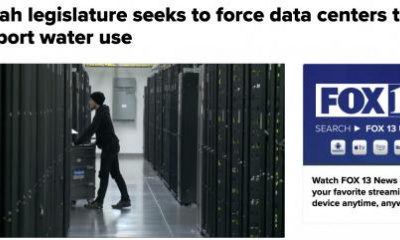When Utah lawmakers went to work in 2022, it was dubbed “the year of water,” with a big focus on the ailing Great Salt Lake. A good chunk of the 45-day work session was devoted to revamping water law and allocating money to conservation programs.
That same vigor didn’t occur, two years later, during the 2024 legislative session.
Great Salt Lake has garnered attention in recent years as water levels decline and its salinity rises. A record-breaking winter last year helped the lake, but it’s not out of the woods.
The lake is currently at 4,194.2 feet, which is “the same as the peak elevation we saw last June of 2023,” said Christine Rumsey, a U.S. Geological Survey hydrologist. Even with the “spring snowmelt ahead of us,” the lake is 4 feet from the lower “healthy” target range established in the state’s first Great Salt Lake strategic planof 4,198 to 4,205 feet above sea level.
While this session was not a “monumental water policy year” like 2022, Tim Davis, deputy Great Salt Lake commissioner, said the Legislature “has made huge strides in setting up the foundation for conserving water [and] getting it to the lake.”
Even then, Katie Newburn, the director of education and outreach with FRIENDS of Great Salt Lake, gave the Legislature “an average” rating on water policy pertaining to the lake. She said it wasn’t a “transformative” year “but passing.” Overall, she believes the moves made at Utah’s Capitol this year “keeps us moving in the right direction.”
Davis and Newburn both agree that lawmakers focused on “technical changes that needed to be made,” in regards to measuring, tracking and saving water. Here’s the breakdown of what lawmakers did in 2024 for the Great Salt Lake.
Knowing when water gets to the Great Salt Lake
HB61 sets up a framework for the state engineer to install telemetry technology to measure the flow of water coming into and being diverted from the lake in real-time instead of having to collect that data in an “analog fashion,” Davis said.
“It's a big deal because we need to know how much water we're using, how much water we're conserving, and then, when water has been dedicated to the lake that it's actually getting to the lake,” he said. “And you would think that we had all that data already, but we don't.”
For Newburn, accurately measuring the water “should be our first priority” because “you can’t manage what you can’t measure.”
Lawmakers also clarified the definition of “saved water” and what water users, especially farmers, can do with it in SB18. There are two prongs, Davis said. One deals with depletion and the other with diversion.
If a farmer has reduced their depletion amount through agricultural optimization or another mechanism, Davis said that is “saved water that then could be dedicated, in our case, to another use like the lake.”
Saved water also pertains to water that hasn’t been diverted for another purpose. So if a farmer didn’t use their entire in-stream water right, it could “then be dedicated to another non-consumptive use,” such as bolstering the Great Salt Lake.
Getting mineral extraction companies on board
The most celebrated piece of legislation was HB453. Davis called it “probably the most impactful piece of Great Salt Lake legislation,” to come out of the session.
The bill creates tax incentives for the lakes’ mineral extraction companies, like Compass Minerals, to reduce the amount of water they use. If the lake drops below a certain level or reaches a higher salinity level, the companies, through a voluntary agreement, would cut their usage.
Since Great Salt Lake is a terminal lake there hasn’t been a water rights priority system established on it. The bill also tasks the state engineer's office to bring water rights held in the lake into the prior appropriations system, meaning it would establish a “first in time, first in right” model that is already used.
“All the water rights within the meander line, any diversions from the lake itself, need to be brought into the prior appropriation doctrine,” Davis said. “So it's a huge change.”
Essentially, if a mineral company does not have a priority right on the lake, they would be subject to mandatory cuts if there isn’t enough water to go around.
The Utah Division of Forest, Fire and State Lands, the agency that oversees the lake, will be given the power to evaluate some of the unused land and water rights held by mineral extraction companies. Additionally, it protects some of the water upstream from being used by the companies.
“We're making all these investments to save water and get it to the lake. We want to make sure that it's not just getting sucked up into evaporation ponds,” Newburn said.
Not all bills were winners
Davis said there weren't “any policy changes made that are detrimental” to the lake and he’s happy with the millions allocated in funding that’ll help the work continue. The commissioner received $10 million to “secure water for the lake” and help “farmers with leasing water.” And while “good investments” were made this session, Davis said more dollars are needed to complete the vision of restoring the lake to a healthy level.
“I think the state will need to continue to make additional investments in getting water to the lake in the future. It's clearly not going to be enough.”
To Newburn, it was “disappointing to see hesitation” on what she considers “pretty common sense conservation efforts.” She pointed to HB401, which would have restricted when residents could water their lawns. The bill didn’t get a committee hearing and was never up for debate in the House.
“That feels like kind of some low-hanging fruit that we could have gotten accomplished and helps advance our cultural adaptation toward water efficiency,” she said.
Newburn also mentioned HB448, which cleared the House but wasn’t taken up in the Senate, as a missed opportunity. The bill would have implemented reporting requirements around agricultural optimization efforts, which the state has already poured millions into.
“I think that's really important for the future of that program to continue investing in agricultural optimization,” she explained. “I think a lot of our leaders want to know what the return on that investment has been.”








